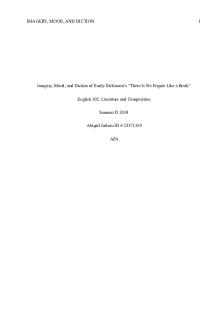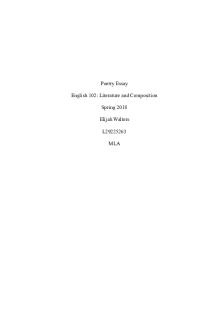Essay Poetry - Grade: A PDF

| Title | Essay Poetry - Grade: A |
|---|---|
| Author | Eli Pa |
| Course | Introduction To Literature |
| Institution | Borough of Manhattan Community College |
| Pages | 3 |
| File Size | 57.2 KB |
| File Type | |
| Total Downloads | 81 |
| Total Views | 145 |
Summary
Essay Poetry...
Description
Professor Pari
ESSAY #1: POETRY
So Close But Yet So Distant
Many of the poems from the Harlem Renaissance seem to have little in common other than being written during that time, since they all convey so many different emotions. However, an interesting close meaning can be found in two of them in particular. The poem “Sonnet to a Negro in Harlem” by Helene Johnson is about a Negro that walks down the street in Harlem, trying but failing to blend with the white people that live in the city, people he hates because of how he is seen through their eyes. The poem “The Harlem Dancer” by Claude McKay, is about a dancer, that sings and dances for money, which are given to her by young men and women, drank and passionate. The poem “Sonnet to a Negro in Harlem” by Helene Johnson, and the poem “The Harlem Dancer” by Claude McKay compare not only the word Harlem in the title, but also other aspects, such as desire to be somewhere else, desire to feel free, to be included. The poem “Sonnet to a Negro in Harlem” by Helene Johnson, is located in Harlem, New York, during the Harlem Renaissance. Throughout the whole poem, very important and firm words are used, such as “magnificent”, “pompous”, “incompetent”. These words define the concept almost perfectly, giving the reader a firm idea of the poem itself. The setting in the poem is in the neighborhood of Harlem, I picture it in a downhill street, I see the Negro walking toward the speaker, which observes him. The Negro tries to imitate the white people, the way he walks, and moves, but he also hate those white people, for how they make him and his similar feel. The Negro tries to fit in with the white people, but he obviously misses home, and would give everything to live free, thought this is not possible where he is from. Black people could hardly fit in the white people world during that time. They were not considered as important as white people, and with this came discrimination. The speaker in the poem, seems to be someone who is observing the Negro in Harlem. The speaker exactly uses strong words to define the Negro, describing him as magnificent and splendid for the city, but also incompetent and arrogant. The speaker seems do despise the Negro, an almost disgust in the speaker words, but the speaker also seems to feel affection toward the Negro, pleasing him, which makes the speaker smile. Life for African Americans was indeed very conflicted. The way the poet writes, using the figurative language through the image, with such vivid words, allows the reader to picture the Negro clearly in the mind. The Negro “with shoulders towering high above the throng, head thrown back in rich barbaric song, palm trees and mangoes stretched before his eyes” (2nd stanza, lines 6,7,8, page 1022). The tone of the speaker is of sadness and pity for the Negro, who so hates the place where he is, but yet tries to blend with the white people, even imitating their ways to do. But the speaker’s tone is also a tone of concern, because he knows the Negro can do much better. The Negro is in fact, as the poet writes, “too splendid for this city street” (3rd stanza, line 14, page 1022). The theme, is a theme of need of belonging, a dream of home, and hard reality for the Negro to blend with others.
The poem is defined a sonnet, because it has fourteen lines in it. The sonnet, defined Petrarchan, contains a group of eight lines, and ending with six lines that contains different rhymes. The rhyme scheme is the same in the first two stanzas, and a little different in the last one. In the first and second stanzas, assigning a letter to each end rhyme, we can see a pattern that goes like this: a, a, b, b, with the words “magnificent”, “gait’, “hate”, “incompetent”, in the first stanza, and c, d, c, d, with the words “despise”, “throng”, “song”, “eyes”, in the second stanza. The last stanza, which is two lines longer than the other stanzas, goes e, f, g, e, f, g with the words “sake”, “gold”, “feet”, “make”, “bold”, “street”. The poem “The Harlem Dancer” by Claude McKay, is also located in Harlem, New York, during the Harlem Renaissance. In this poem, the poet doesn’t write words as strong as in the poem “Sonnet to a Negro in Harlem”, but yet, a strong meaning arouses form the poem. The setting in the poem is the neighborhood of Harlem in New York City. In the poem, the dancer smiles, sings, dances, but the speaker clearly can see what the young men and women cannot: she doesn’t belong there, and she would prefer to go home, rather than dance for few coins. There is a certain sadness in the tone of the poem, a pity for the dancer that dances for money, in front of young people that glaze at her, with jealousy and passion at her glorious body. The theme of the poem, is also a need of belonging in the neighborhood of Harlem, a need of belonging in the midst of the young people, and a dream of a far away home, where being free is not possible. In the poem, the speaker seems to be someone like in the poem “Sonnet to a Negro in Harlem” who is observing the dancer. The speaker is not observing the dancer with the same point of view of the young people gathered around her, but with a point of view of curiosity, wonder. The speaker is also mesmerized and captured by the way the dancer moves and sings, and can see things others can’t. The poet writes about the dancer in a very detailed way. The image of the poem is in fact so clear, that the dancer could stand in front of the reader. Instead of describing her with normal words, the poet writes with metaphor and simile. In the first stanza, line 3 (1023), a simile is found: “Her voice was like the sound of blended flutes”. In the second stanza, lines 7,8 (1023), a metaphor is found: “To me she seemed a proudly-swaying palm – Grown lovelier for passing through a storm”. The rhyme scheme used for the poem, is similar to the poem “Sonnet to a Negro in Harlem” but not quite the same. The poem is also a Shakespearean sonnet. A Shakespearean sonnet in fact has a rhyme scheme that rhymes abab cdcd efef gg. In the first and second stanzas, assigning a letter to each end rhyme, we can see a pattern that goes like this: a, b, a, b, with the words “prostitutes”, “sway”, “flutes”, “day”, in the first stanza, and c, d, c, d, with the words “calm”, “fort”, “palm”, “storm”, in the second stanza. The last stanza, is also different, with a pattern that goes e, f, e, f, g, g, with the words “curls”, “praise”, “girls”, “gaze”, “face”, “place”. These two poems, so different at the beginning, and still different throughout the whole poem, share so many insights, and meanings once read carefully. I would have never thought to find so many things in common and yet find them still different from one another. The poems swiped the smile off my face when I read them, because they are full of sadness and, in an indirect way, describe a world full of sufferance and diversity. Both the Negro and the dancer govern the poems and they both try to fit in a world that is not allowing neither of them to do it. The last line in each of the poem was the line that most caught me. In the poem “Sonnet to a Negro in Harlem”, the last line “You are too splendid for this city street”, emanates such an energy, because the Negro shouldn’t try to fit in with the white people, he shouldn’t walk like them, or talk like them, or move like them, because he, he is a Negro, and a Negro is just as important as a white person, and in order to live, and fit in, he just needs to be himself. In the poem “The Harlem Dancer”, the last line “I knew her self was not in that strange place”, shows the whole meaning of the poem, the struggle of the dancer at dancing for a couple of coins, and the
sadness to be there instead of home. But yet she must do it, she must dance for the people and take the money for her living. White people considered black people different in term of intelligence, hard work, and the ability to be good for their cities. And this form of racism, prevented black people from achieving the same things as white people did. In a city where everybody should have been the same, yet we find many differences, many prejudices, and many people who needed to just live and worry less about being different. These two poems show the real struggle and sacrifices that African American had to experience and live in every day life. Struggle to live in a world where they were not accepted and neglected, and sacrifices such as limit their own personalities in order to fit with the white world. And even though they did what they could to blend with the white world, such as dancing half naked and walking and talking like them, racism was still present, a form of racism that limited their lives and their actions toward what would have been a better and prosperous future....
Similar Free PDFs

Poetry Essay - Grade: A+
- 5 Pages

Essay Poetry - Grade: A
- 3 Pages

Poetry Essay - Grade: 80%
- 6 Pages

Poetry Essay - Grade: B
- 5 Pages

Poetry Paper 2 - Grade: a
- 7 Pages

Capstone essay - Grade: A+
- 10 Pages

Nutrition Essay - Grade: A
- 4 Pages

Abortion (Essay) - Grade: A
- 4 Pages

Essay 2 - Grade: A-
- 4 Pages

Othello Essay - Grade: A+
- 2 Pages

Coraline Essay - Grade: A-
- 3 Pages
Popular Institutions
- Tinajero National High School - Annex
- Politeknik Caltex Riau
- Yokohama City University
- SGT University
- University of Al-Qadisiyah
- Divine Word College of Vigan
- Techniek College Rotterdam
- Universidade de Santiago
- Universiti Teknologi MARA Cawangan Johor Kampus Pasir Gudang
- Poltekkes Kemenkes Yogyakarta
- Baguio City National High School
- Colegio san marcos
- preparatoria uno
- Centro de Bachillerato Tecnológico Industrial y de Servicios No. 107
- Dalian Maritime University
- Quang Trung Secondary School
- Colegio Tecnológico en Informática
- Corporación Regional de Educación Superior
- Grupo CEDVA
- Dar Al Uloom University
- Centro de Estudios Preuniversitarios de la Universidad Nacional de Ingeniería
- 上智大学
- Aakash International School, Nuna Majara
- San Felipe Neri Catholic School
- Kang Chiao International School - New Taipei City
- Misamis Occidental National High School
- Institución Educativa Escuela Normal Juan Ladrilleros
- Kolehiyo ng Pantukan
- Batanes State College
- Instituto Continental
- Sekolah Menengah Kejuruan Kesehatan Kaltara (Tarakan)
- Colegio de La Inmaculada Concepcion - Cebu




